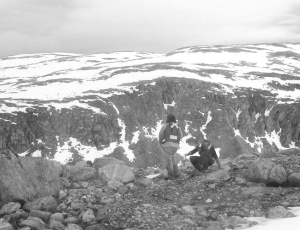BHP Billiton (BHP-N, BLT-l), the principal owner of Canada’s wildly successful Ekati diamond mine in the Northwest Territories, seems to think Peregrine Diamonds’ (PGD-t) Chidliak project, on southern Baffin Island in Nunavut, may just be the next big thing in Canadian diamond history.
BHP has announced that it will exercise its earn-in rights for a 51% interest in the 9,800-sq.-km property. Peregrine has identified three diamondiferous kimberlites at Chidliak this year, including CH-1, which is estimated at six hectares in size and is exposed at surface.
“We think it’s one of the best diamond projects in the world and the fact that BHP Billiton is backing in this early on demonstrates that,” Eric Friedland, Peregrine’s chief executive, said in a telephone interview from Vancouver.
Adds Brooke Clements, Peregrine’s president: “To the best of our knowledge, it’s the first time BHP has ever done an earn-in arrangement on a Canadian diamond project.”
In order to earn an initial 51% interest, BHP must spend $22.3 million on future exploration at the property.
(Under the 2005 exploration agreement, BHP can earn its 51% interest by funding five times the amount Peregrine has spent on exploration, over five years, with minimum annual spending of $5 million.)
Once BHP Billiton has earned a 51% stake, it will have a one-time option to earn an additional 7% interest by footing the bill for a bankable feasibility study.
If that option is exercised, BHP Billiton would hold a 58% interest and Peregrine 42% in any potential mine on the property.
If BHP does exercise the second option but fails to complete it, however, Peregrine will have the right to complete the bankable feasibility itself to earn a 58% interest in Chidliak.
Peregrine can market its share of any diamond production after the first three years of commercial production if BHP earns a 58% stake in the property.
If Peregrine has funded either its pro-rata share or the full costs of the feasibility study, it has the marketing rights to its share of diamonds at the start of production.
Friedland notes that the industry has learned a lot about diamonds in the last 10 years and is now in a position to evaluate kimberlites faster and put them in production sooner than they could a decade ago. Moreover, the supply and demand fundamentals for diamonds look good, he says.
“In our industry, diamonds are some of the most difficult things to find — but they make the most money of any commodity that we are aware of and the supply-demand fundamentals are still very good,” Clements adds. “There is still no new supply coming on-stream and I think once the economic situation stabilizes, there will be a real focus on projects like Chidliak.”
In the meantime, the two companies are busy finalizing the details of next year’s exploration program. That program will focus on further evaluation of the three known kimberlites, exploration to discover additional diamondiferous kimberlites, and validating more than 170 known kimberlite-type geophysical anomalies.
“The important thing is that with BHP’s experience, the project can be efficiently evaluated and decisions can be made on which kimberlites to advance because it’s an expensive process,” Clements notes. “With their experience at Ekati, it puts us in a position to evaluate the project properly and efficiently.”
Adds Friedland: “They’re in a good position to judge a project like this because they’ve taken the Ekati diamond project from discovery to commercial production.”
Under the agreement, Peregrine will continue to act as operator of the exploration program. BHP is entitled to become the operator, however, at any time while it is sole-funding operations.
“The fact that they’re allowing us to continue on as operator says a lot about our operations team,” Friedland says. “They’re entrusting us to spend their money and that’s no small thing.”
On Nov. 18, Peregrine announced that a 2.28-tonne sample collected from CH-1 returned a diamond content of 1.56 carats per tonne. The same sample yielded a 2.01-carat, gem-quality, octahedron diamond.
“Recovering a stone of this size and nature from such a small sample is on a par with discovering a 1.75-carat diamond embedded in the A154 South discovery core hole at Diavik,” John Kaiser wrote in a Nov. 18 report of his online newsletter, Kaiser Bottom-Fish.
Kaiser, who since late August has recommended Peregrine three times as a good speculative value buy, says “information available to us about Chidliak cannot get any better for this early stage of exploration” and notes the undrilled CH- 1kimberlite is exciting news in Canadian diamond exploration history.
“Based on the geophysical signature and the distribution of kimberlitic rubble, the company is inferring a pipe-like body with a surface area of six hectares,” Kaiser wrote. “Such a body with steep-sided walls would represent a tonnage footprint of 25-35 million tonnes to a depth of 300 metres, which would rank among the larger pipes in Canada’s Arctic.”
At presstime, Peregrine was trading at about 44 per share in a 12- month range of 16.5-$1.42 per share.


Be the first to comment on "BHP Backs In On Peregrine’s Chidliak"